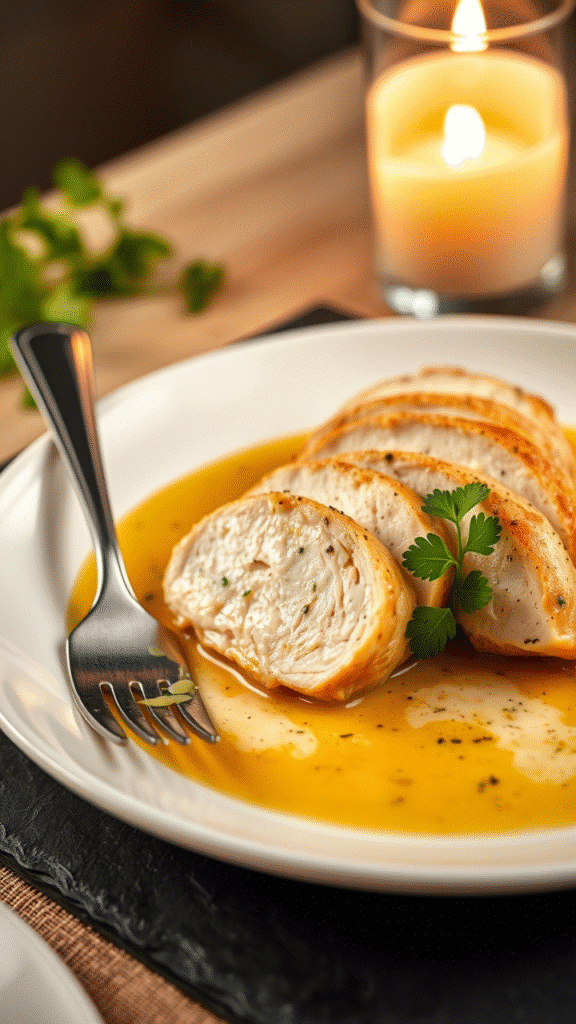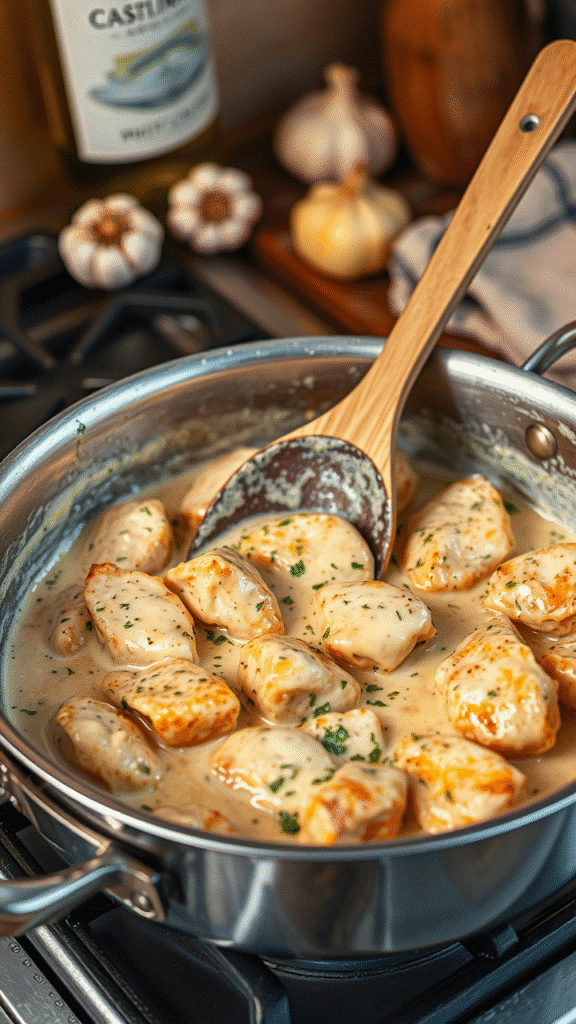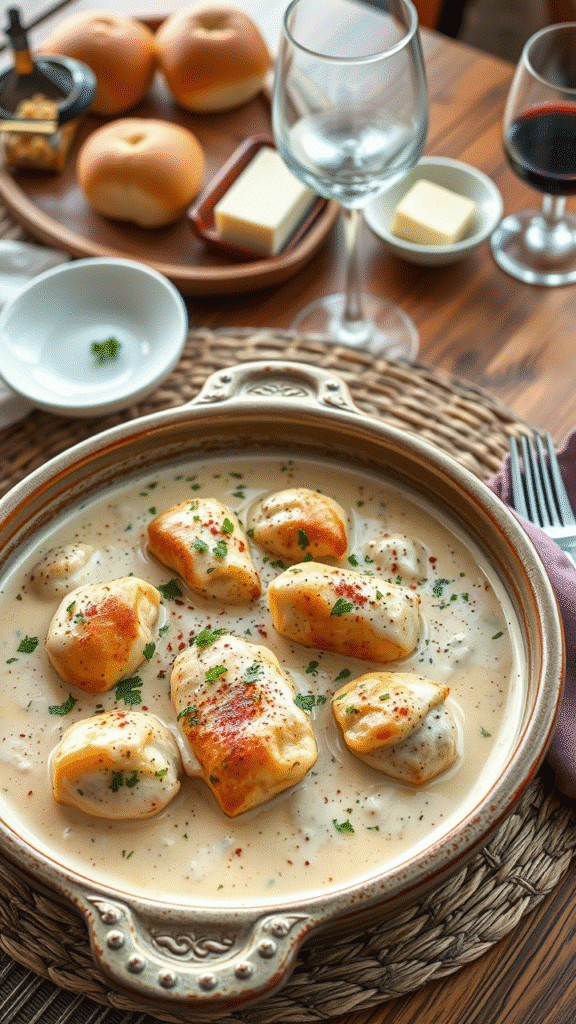The first time I tasted properly executed creamy garlic chicken, I was working the sauté station at a small bistro in Lyon. The chef a temperamental Frenchman who’d throw plates when the hollandaise broke demonstrated how twenty cloves of garlic could transform from pungent aggressors into sweet, caramelized allies. That moment changed everything I thought I knew about this seemingly simple dish.
Most home cooks approach creamy garlic chicken like it’s just another weeknight dinner. They’re missing the profound transformation that occurs when technique meets timing, when each component builds upon the last to create something greater than its parts. This isn’t merely chicken in cream sauce it’s a masterclass in flavor development, textural contrast, and the alchemy of proper seasoning.
What Makes This Recipe Special
Creamy garlic chicken represents the intersection of French technique and universal comfort food appeal. The dish relies on the Maillard reaction to develop complex flavors in the chicken, while gentle confit-style cooking transforms harsh garlic into silky sweetness. The cream doesn’t just bind the sauce it becomes a canvas for herb oils and fond to paint their flavors across.
The magic happens in layers. First, the chicken develops a golden crust that provides textural contrast and concentrated flavor compounds. Then aromatics bloom in the rendered fat, creating the foundation for depth. Finally, deglazing captures every caramelized bit, while cream tempers acidity and creates that luxurious mouthfeel professional kitchens are known for.
Ingredients & Substitutions

Primary Proteins
- 6 boneless, skinless chicken thighs (2.5-3 lbs total)
- Alternative: chicken breasts, but thighs provide superior flavor and moisture retention
Aromatics & Flavor Base
- 20 garlic cloves, peeled and left whole
- 1 large shallot, finely minced
- 2 sprigs fresh thyme
- 1 bay leaf
- 1/4 cup fresh parsley, chopped (reserve stems)
Liquid Components
- 1/2 cup dry white wine (Sauvignon Blanc or Pinot Grigio work exceptionally)
- 1 cup heavy cream (35% fat minimum)
- 1/2 cup chicken stock, preferably homemade
- 2 tablespoons fresh lemon juice
Seasoning & Fats
- 2 tablespoons olive oil
- 3 tablespoons unsalted butter
- 1 teaspoon kosher salt (plus more for seasoning)
- 1/2 teaspoon white pepper
- 1/4 teaspoon smoked paprika
Smart Substitutions
When heavy cream isn’t available, créme fraîche provides similar richness with added tang. For dairy-free versions, full-fat coconut cream works surprisingly well, though you’ll lose some of the traditional flavor profile. The key is maintaining fat content low-fat alternatives will break under heat.
Chicken thighs remain the professional choice due to their higher fat content and forgiving nature. However, if using breasts, pound them to even thickness and reduce cooking time significantly. Bone-in thighs add more flavor but require longer cooking and careful temperature monitoring.
For wine substitutions, avoid anything too oaky or sweet. A dry vermouth can replace white wine in a pinch, while chicken stock with a splash of white wine vinegar provides acidity without alcohol.
Step-by-Step Instructions

Preparation Phase
Begin by bringing chicken to room temperature this ensures even cooking and prevents the exterior from overcooking while the interior catches up. Pat each piece completely dry with paper towels, then season generously with salt and white pepper at least 30 minutes before cooking. This pre-seasoning allows salt to penetrate the meat, enhancing flavor throughout.
Prepare your garlic by smashing each clove lightly with the flat side of your knife, then removing the papery skin. Leave cloves whole they’ll cook more evenly and provide better visual appeal than minced garlic, which burns easily in hot fat.
Building the Foundation
Heat olive oil in a heavy-bottomed skillet or Dutch oven over medium-high heat until shimmering. The pan should be hot enough that chicken sizzles immediately upon contact but not so hot that oil smokes. This temperature sweet spot creates proper browning without burning.
Sear chicken thighs skin-side down first, resisting the urge to move them for 4-5 minutes. Properly seared chicken will release naturally when ready to flip if it’s sticking, it needs more time. Look for deep golden-brown color and crispy edges. Flip and sear the other side for 3-4 minutes, then remove to a plate.
The Garlic Transformation
Reduce heat to medium-low and add whole garlic cloves to the remaining fat. This is where patience becomes your greatest tool. Cook garlic slowly, turning occasionally, until cloves become golden and soft, about 8-10 minutes. They should yield to gentle pressure and smell sweet rather than sharp.
The slow cooking process converts garlic’s harsh allicin compounds into mellower, sweeter molecules. Rush this step, and you’ll have bitter, acrid flavors that no amount of cream can mask. Properly cooked garlic should be jammy inside and caramelized outside.
Deglazing and Sauce Development
Add minced shallots to the garlic, cooking until fragrant and translucent, about 2 minutes. Pour in white wine, scraping up any browned bits with a wooden spoon. These fond particles contain concentrated flavor compounds that elevate the entire dish.
Let wine reduce by half, concentrating its flavors and cooking off harsh alcohol notes. Add thyme, bay leaf, and parsley stems, allowing herbs to bloom in the warm mixture. The reduction should smell bright and aromatic, not boozy.
Stream in chicken stock and cream, whisking gently to combine. Bring to a gentle simmer vigorous boiling will break the cream and create an unappetizing appearance. Season with salt, white pepper, and smoked paprika.
Final Cooking and Assembly
Nestle chicken thighs back into the sauce, ensuring they’re partially submerged but not completely covered. Cover partially and simmer gently for 15-20 minutes, until chicken reaches 165°F internal temperature. The gentle heat prevents cream from breaking while allowing flavors to meld.
In the final minutes, add lemon juice and remaining butter, swirling to create a glossy, emulsified sauce. Taste and adjust seasoning the dish should be rich but balanced, with garlic sweetness supported by herb brightness and gentle acidity.
Cooking Techniques & Science

The Maillard Reaction
Proper searing creates hundreds of flavor compounds through the Maillard reaction the browning that occurs when proteins and sugars react under heat. This reaction only happens efficiently at temperatures above 280°F, which is why thorough drying and hot oil are crucial. The crispy, caramelized surface provides textural contrast and concentrated flavor that permeates the entire dish.
Garlic Chemistry
Raw garlic contains alliin, which converts to allicin when crushed creating that sharp, pungent bite. Gentle cooking transforms these compounds into sweet, nutty flavors through caramelization and the breakdown of sulfur compounds. Whole cloves cook more evenly than minced garlic, preventing burning while maximizing sweetness development.
Cream Science
Heavy cream’s high fat content (35%+) provides stability against heat and acid. Lower-fat alternatives lack this protection and will curdle when combined with wine’s acidity or high heat. The fat also carries fat-soluble flavors and creates the luxurious mouthfeel that defines the dish.
Proper emulsification occurs when fat molecules are suspended in liquid through gentle agitation. Adding cold butter at the end (monte au beurre) creates a glossy finish and rounds out sharp flavors through fat’s mellowing effect.
Temperature Control
Maintaining gentle heat prevents protein coagulation in both cream and chicken. Vigorous boiling creates tough, stringy chicken and broken cream sauce. The ideal temperature hovers around 185-190°F hot enough for flavor development but gentle enough to preserve texture.
Serving & Pairing Suggestions
Presentation Excellence
Serve creamy garlic chicken in warmed bowls to maintain sauce consistency. Arrange chicken pieces to show off golden-brown surfaces while ensuring each portion includes several softened garlic cloves. Drizzle extra sauce around the plate’s edge and garnish with fresh parsley and a light dusting of smoked paprika.
For elegant plating, use a large spoon to create swooshes of sauce across the plate before placing chicken. This restaurant technique adds visual sophistication while ensuring every bite includes creamy sauce.
Complementary Sides
Buttery mashed potatoes provide the classic pairing, their starchy richness complementing the garlic-infused cream. However, consider alternatives that won’t compete with the dish’s richness: roasted asparagus with lemon zest, simple steamed rice, or crusty bread for sauce absorption.
A bright, acidic salad cuts through the richness beautifully. Arugula with lemon vinaigrette or a simple green salad with champagne vinegar provides palate-cleansing contrast. Roasted root vegetables add earthy complexity without overwhelming the dish’s delicate balance.
Wine Pairing
White wines with good acidity and moderate body work best. A crisp Chardonnay echoes the cream while providing cutting acidity. Sauvignon Blanc’s herbaceous notes complement the garlic and herbs, while a light Pinot Noir offers enough body to stand up to the rich sauce without overwhelming delicate flavors.
Avoid heavily oaked wines that compete with the dish’s subtle complexity. The goal is harmony, not competition between food and wine.
Common Mistakes and Solutions

Temperature Troubles
The most frequent error involves cooking over too-high heat, which breaks the cream and creates tough chicken. If your sauce separates, remove from heat immediately and whisk in a tablespoon of cold cream off the heat. Prevention beats correction maintain gentle heat throughout.
Garlic Gone Wrong
Burned garlic ruins the entire dish with bitter, acrid flavors. If garlic starts browning too quickly, remove the pan from heat and add a splash of cold stock to stop the cooking. Start over if garlic becomes dark brown there’s no recovering from burned garlic.
Timing Issues
Starting with cold chicken leads to uneven cooking and extended searing time, which can burn aromatics. Always bring chicken to room temperature before cooking. If running behind schedule, submerge sealed chicken in warm water for 10 minutes rather than starting cold.
Sauce Consistency
Thin sauce results from insufficient reduction or too much liquid. Increase heat slightly and cook uncovered to concentrate flavors and thicken consistency. Conversely, overly thick sauce can be loosened with warm stock or cream, whisked in gradually.
Advanced Variations
Herb Variations
Experiment with different herb combinations: rosemary and sage for earthy depth, tarragon for French elegance, or oregano and basil for Italian inspiration. Add woody herbs early with aromatics, while delicate herbs should be stirred in just before serving.
Protein Alternatives
This technique works beautifully with pork tenderloin medallions, reducing cooking time to 12-15 minutes total. Fish fillets like cod or halibut require only 6-8 minutes cooking time and benefit from increased lemon juice for brightness.
Seasonal Adaptations
Spring versions might include asparagus spears and fresh peas. Summer adaptations could feature cherry tomatoes and fresh basil. Fall versions benefit from roasted butternut squash or mushrooms, while winter calls for root vegetables and heartier herbs.
Conclusion
Mastering creamy garlic chicken requires understanding that simplicity and technique aren’t mutually exclusive. The dish’s elegance lies in its restraint each component serves a specific purpose in creating the final harmony. Perfect execution comes from respecting ingredients, controlling temperature, and allowing time for proper flavor development.
The key lies in patience. Let the chicken sear properly, cook garlic gently, and allow sauce to develop naturally. These fundamentals create restaurant-quality results in home kitchens. Remember that cooking is both science and art understand the principles, then trust your senses to guide the final touches.
Whether serving family dinner or entertaining guests, this dish delivers sophistication without pretension. It’s comfort food elevated through technique, proving that the best cooking often comes from treating simple ingredients with profound respect.
Frequently Asked Questions?
Can I make this dish ahead of time?
Creamy garlic chicken reheats beautifully, making it excellent for meal prep or entertaining. Cool completely before refrigerating, then reheat gently over low heat, adding a splash of cream if the sauce seems thick. The flavors actually improve after resting overnight as ingredients meld together. Avoid reheating in the microwave, which can break the cream sauce and create an unappetizing texture.
What’s the best way to store leftover creamy garlic chicken?
Store leftovers in the refrigerator for up to three days in an airtight container. The cream sauce will thicken considerably when cold, which is normal. When reheating, add a tablespoon or two of warm chicken stock or cream to restore the proper consistency. Heat slowly over medium-low heat, stirring occasionally to prevent sticking or breaking.
Can I freeze this dish?
While possible, freezing isn’t recommended for cream-based sauces as they tend to separate when thawed. If you must freeze, undercook the chicken slightly and freeze without the cream sauce. Thaw completely in the refrigerator, then finish cooking with fresh cream sauce. The texture won’t be quite as smooth as freshly made, but the flavors will still be delicious.
How do I prevent the cream from curdling?
Cream curdling occurs when proteins coagulate due to high heat or acid. Always use heavy cream with at least 35% fat content, which provides stability. Keep heat at medium-low once cream is added, and never let the sauce boil vigorously. If using wine, let it reduce before adding cream to minimize acidity. Adding cream gradually while whisking also helps prevent curdling.
What can I do if my garlic burns?
Unfortunately, burned garlic cannot be saved and will impart bitter flavors to the entire dish. If garlic starts browning too quickly, immediately remove the pan from heat and add a splash of cold liquid to stop the cooking process. For severely burned garlic, start over with fresh cloves it’s better to lose a few minutes than ruin the entire dish with bitter flavors.

Veronica is a passionate food enthusiast with over three years of experience in exploring and writing about diverse cuisines. Her expertise lies in reviewing restaurants, sharing creative recipes, and discovering the latest food trends. As the voice behind FoodieRecap.com, Anju brings fresh perspectives and culinary insights to her audience.
